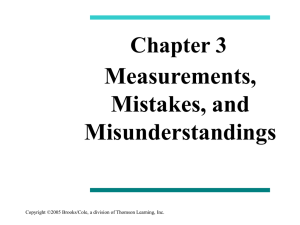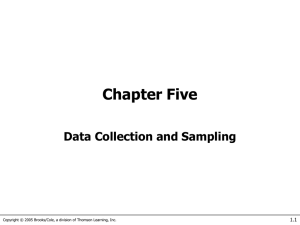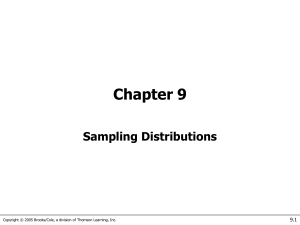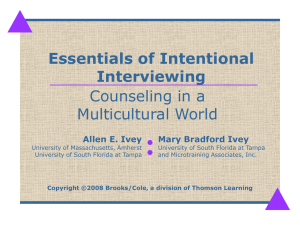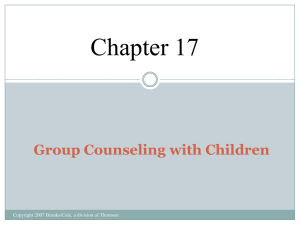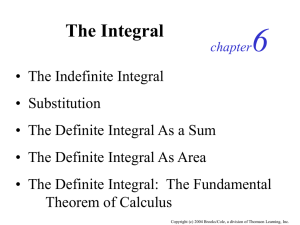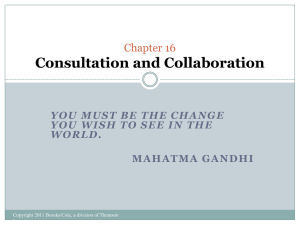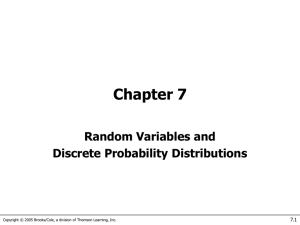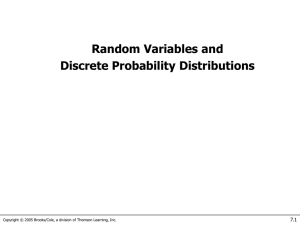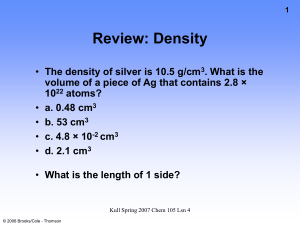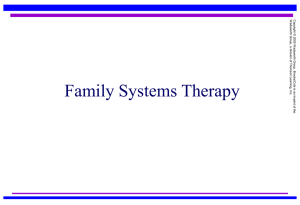Essentials of Intentional Interviewing Copyright ©2008 Brooks/Cole
advertisement
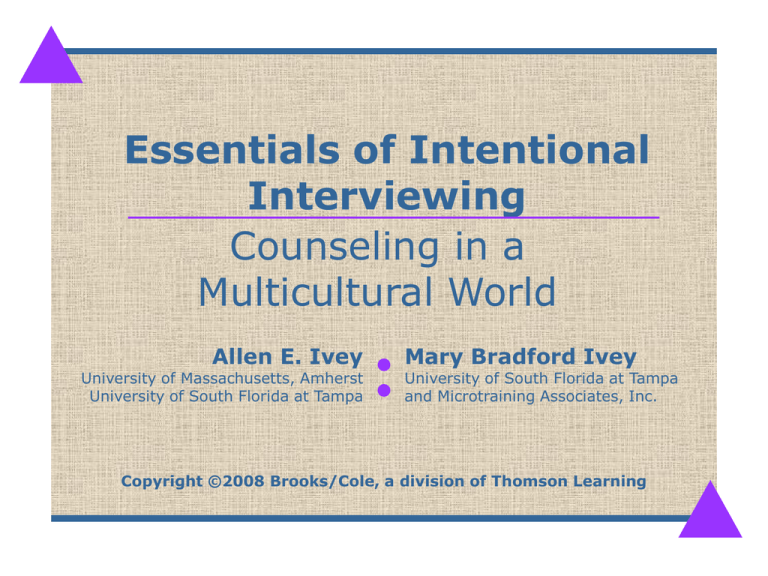
Essentials of Intentional Interviewing Counseling in a Multicultural World Allen E. Ivey University of Massachusetts, Amherst University of South Florida at Tampa Mary Bradford Ivey University of South Florida at Tampa and Microtraining Associates, Inc. Copyright ©2008 Brooks/Cole, a division of Thomson Learning Chapter 1 Skilled Interviewing and Counseling Copyright ©2008 Brooks/Cole, a division of Thomson Learning Chapter Goals Define and discuss interviewing, counseling and psychotherapy. Assess yourself as holistic and a unique multicultural being. Recognize the importance of a positive approach. Define cultural intentionality and intentional competence. Copyright ©2008 Brooks/Cole, a division of Thomson Learning Slide One Chapter Goals Slide Two Gain knowledge of the microskills hierarchy. Recognize that microskills are used in all counseling theories. Record/document your natural style. Compare your natural style with your subsequent skill development. Copyright ©2008 Brooks/Cole, a division of Thomson Learning Interviewing Basic process for gathering information, problem solving and advice giving. Interviewers may be: Guidance and counseling staff Medical personnel Business people Wide variety of helping professionals Copyright ©2008 Brooks/Cole, a division of Thomson Learning Counseling Counseling is more intensive and personal than interviewing. Counselors help people with normal problems / opportunities. Counseling most often associated with: Social work Guidance Pastoral counseling Copyright ©2008 Brooks/Cole, a division of Thomson Learning Psychology Psychiatry, to a limited extent Psychotherapy Psychotherapy is more intense than counseling. Focuses on deep-seated personality or behavioral difficulties. Intentional interviewing skills are equally important for effective psychotherapy. Copyright ©2008 Brooks/Cole, a division of Thomson Learning Interrelationships Interviewing Counseling Psychotherapy Figure 1-1 The interrelationship of interviewing, counseling, and psychotherapy Copyright ©2008 Brooks/Cole, a division of Thomson Learning Clinical Counseling New Terminology Covers the same areas as shown in Figure 1.1 Engages in therapeutic practice. Demands competence: Interviewing Counseling Diagnosis Treatment Copyright ©2008 Brooks/Cole, a division of Thomson Learning Multicultural World Slide One “As all behaviors are learned and displayed in a cultural context, all interviewing and counseling are multicultural.” Paul Pedersen (2006) Copyright ©2008 Brooks/Cole, a division of Thomson Learning Multicultural Trust World Is the Issue, Slide Two Account for cultural differences. Ensure minorities receive mental health care tailored to their needs. Discuss obvious multicultural differences early in the session. Use common sense and skilled judgment. Copyright ©2008 Brooks/Cole, a division of Thomson Learning RESPECTFUL Model Multicultural Review Issues, D’Andrea & Daniels, 2001 R Religion/spirituality E Economic/class background S Sexual identity P Personal style E Ethnic/racial identity C Chronological/lifespan challenges T Trauma F Family background U Unique physical characteristics L Location of residence/language Copyright ©2008 Brooks/Cole, a division of Thomson Learning Positive Orientation Focus on Strengths and Wellness Story: As told by the client. Positive Assets: Build on positive aspects and client’s strengths. Restory: Generate new ways for the client to talk about themselves. Action: Help the client bring new ways of thinking and being into action. Copyright ©2008 Brooks/Cole, a division of Thomson Learning Positive Orientation Drawing Out Client Stories Listening Strength Development New Perspectives Action Planning Copyright ©2008 Brooks/Cole, a division of Thomson Learning Cultural Intentionality Alternative for Cultural Differences Cultural Intentionality is assessing client cultural background and flexing microskill application to achieve specific results. Recognize that the result achieved from use of specific microskills may vary widely among clients from different cultures. Copyright ©2008 Brooks/Cole, a division of Thomson Learning Cultural Intentionality Alternatives for Cultural Differences Know and integrate communication styles and relationship experiences of diverse cultural groups into your own personal helping style. Age Ethnicity Health Race Individuality Ability Gender Lifestyle Sexual Orientation Religion / Spirituality Copyright ©2008 Brooks/Cole, a division of Thomson Learning Disability Development Intentionality Developing Multiple Responses Intentionality is acting with a sense of capability. Choosing from among a range of alternative actions, thoughts, and behaviors in responding to changing life situations. Copyright ©2008 Brooks/Cole, a division of Thomson Learning Intentionality Developing Multiple Responses Listen first; solve problems later. Avoid “perfect” solutions. Avoid jumping to the “right” response too soon. Adapt your style to suit different individuals / cultures. Copyright ©2008 Brooks/Cole, a division of Thomson Learning Intentional Competence Developing Multiple Responses Intentional Competence is integrating your natural style, self-understanding, and artistic abilities with the somewhat predictable client responses from your use of the microskills, allowing you to flex and change direction in order to be with your client in new ways, required for their development. Copyright ©2008 Brooks/Cole, a division of Thomson Learning Intentional Prediction Expect Specific Results From Specific Use of Microskills As an example… Open Questions Begin an interview. Open new topics and pinpoint/clarify details. Identify specifics. Assist with client / situation assessment. Closed Questions Focus the interview Reveal specific details. Close down client talk. Increase interviewer control. Copyright ©2008 Brooks/Cole, a division of Thomson Learning Predicted Result Expect Specific Results From Specific Use of Microskills As an example… Open Questions Encourage more pertinent detail. Clients talk more and give more detail. Closed Questions Encourage more focused client talk. Encourage more pertinent detail Encourage less wandering. Clients provide specific information. Copyright ©2008 Brooks/Cole, a division of Thomson Learning Microskills Approach Intentional Client Interaction Foundation of intentional interviewing Communication skill units of the interview Summarizes successive steps Provides different alternatives for use with different clients and in different situations See Figure 1-2, p. 13 Copyright ©2008 Brooks/Cole, a division of Thomson Learning Copyright ©2008 Brooks/Cole, a division of Thomson Learning Microskills Approach Five-Step Model for Microskill Develoment 1.Define the skill, central features, and purpose. 2.Observe the skill in action. 3.Learn the skill and its implications. 4.Practice the skill in role-play. 5.Plan for generalization. Copyright ©2008 Brooks/Cole, a division of Thomson Learning Microskills Approach Intentional Client Interaction Expect results. Practice is essential. Multicultural differences are real. Different theories have different patterns of skill usage. Consistently, specific microskills result in predictable client responses. Copyright ©2008 Brooks/Cole, a division of Thomson Learning Chapter 1 Skills Practice What is Your Natural Helping Style? Copyright ©2008 Brooks/Cole, a division of Thomson Learning Baseline Interview Finding Your Natural Style Audio- or videotape a baseline interview using your natural style. Helpful to acquire a written transcript of the interview for a study script. Compare baseline with subsequent skills practice and development. Copyright ©2008 Brooks/Cole, a division of Thomson Learning Guidelines For Baseline Audio- or Videotape Recording, Slide One Find a volunteer client willing to role-play a concern, problem, opportunity, or issue. Interview the volunteer client for at least 15 minutes. Seek to avoid sensitive topics. Use your own natural communication style. Ask the volunteer client, “May I record this interview?” Inform the client that the tape recorder may be turned off at any time.. Copyright ©2008 Brooks/Cole, a division of Thomson Learning Guidelines For Baseline Audio- or Videotape Recording, Slide Two Select a topic. You and the client may choose multicultural dimensions, interpersonal conflict, a specific issue selected by the client, or one of the elements from the RESPECTFUL model. Follow ethical guidelines. Request that your volunteer client complete the Client Feedback Form. (Box 1-3, p. 19) Compare this baseline with subsequent recordings of your work later in this course. Copyright ©2008 Brooks/Cole, a division of Thomson Learning Self-Assessment Ask Yourself the Following Questions What did you do that was effective and helpful? What did you learn from the Client Feedback Form? Identify one thing you would like to improve. What strengths do you bring to interviewing overall? Copyright ©2008 Brooks/Cole, a division of Thomson Learning
